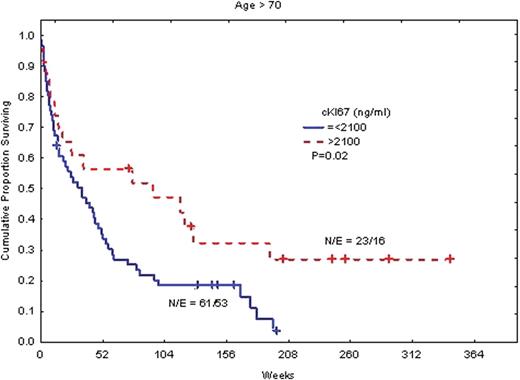Abstract
Abstract 3104
Poster Board III-41
Ki-67 and caspase-3 are widely accepted as proliferation and apoptosis markers in human tumors. We recently reported that Ki-67 can be detected as a circulating protein (cKi-67) in the plasma of patients with acute lymphoblastic leukemia (ALL), and that higher levels in plasma correlated with more aggressive disease. Here we investigated the levels of cKI-67 in patients with acute myeloid leukemia (AML). Since both apoptosis and proliferation are interconnected in defining the biology of a cancer, we also evaluated the level of apoptosis in AML as determined by caspase-3 activity in plasma. The study included a group of 106 newly diagnosed AML patients and 98 normal control subjects. We used the Meso Scale Discovery system for determining the levels of cKi-67. Apoptosis was determined by measuring caspase-3 activity (DEVD) in the plasma using a standard enzymatic fluorogenic assay. Median (range) levels of cKi-67 were significantly higher in patients with AML than in control subjects (1301 [0-6789] ng/mL vs 339 [35.76-2830.65] ng/mL; P<0.0001), as were caspase-3 activity levels (11.9 [5.8-218.2] pmol/min vs 8.27 [4.54-34.30] pmol/min; P<0.0001). Neither cKi-67 level nor caspase-3 activity correlated with white cell count, hemoglobin, platelet count, lactate dehydrogenase, blast count, age, cytogenetic grouping, or performance status. However, high levels (above the upper quartile of 2100 ng/mL) of cKi-67 were significantly associated with longer survival among patients >70 years of age (n=84; P=0.02) and those with unfavorable cytogenetics (n=38; P=0.006). On the other hand, high levels of caspase-3 activity (above upper quartile of 14 pmol/min) were associated with shorter survival (P=0.02) irrespective of age or cytogenetic grouping. In conclusion, proliferation and apoptosis as determined by plasma cKi-67 level and caspase-3 activity are unusual in AML. In that, higher proliferation and lower apoptosis are associated with better survival, most likely reflecting that cells progressing through the cell cycle may respond better to chemotherapy. These measurements should be considered in new therapeutic approaches that target cell cycle.
No relevant conflicts of interest to declare.
Author notes
Asterisk with author names denotes non-ASH members.


This feature is available to Subscribers Only
Sign In or Create an Account Close Modal